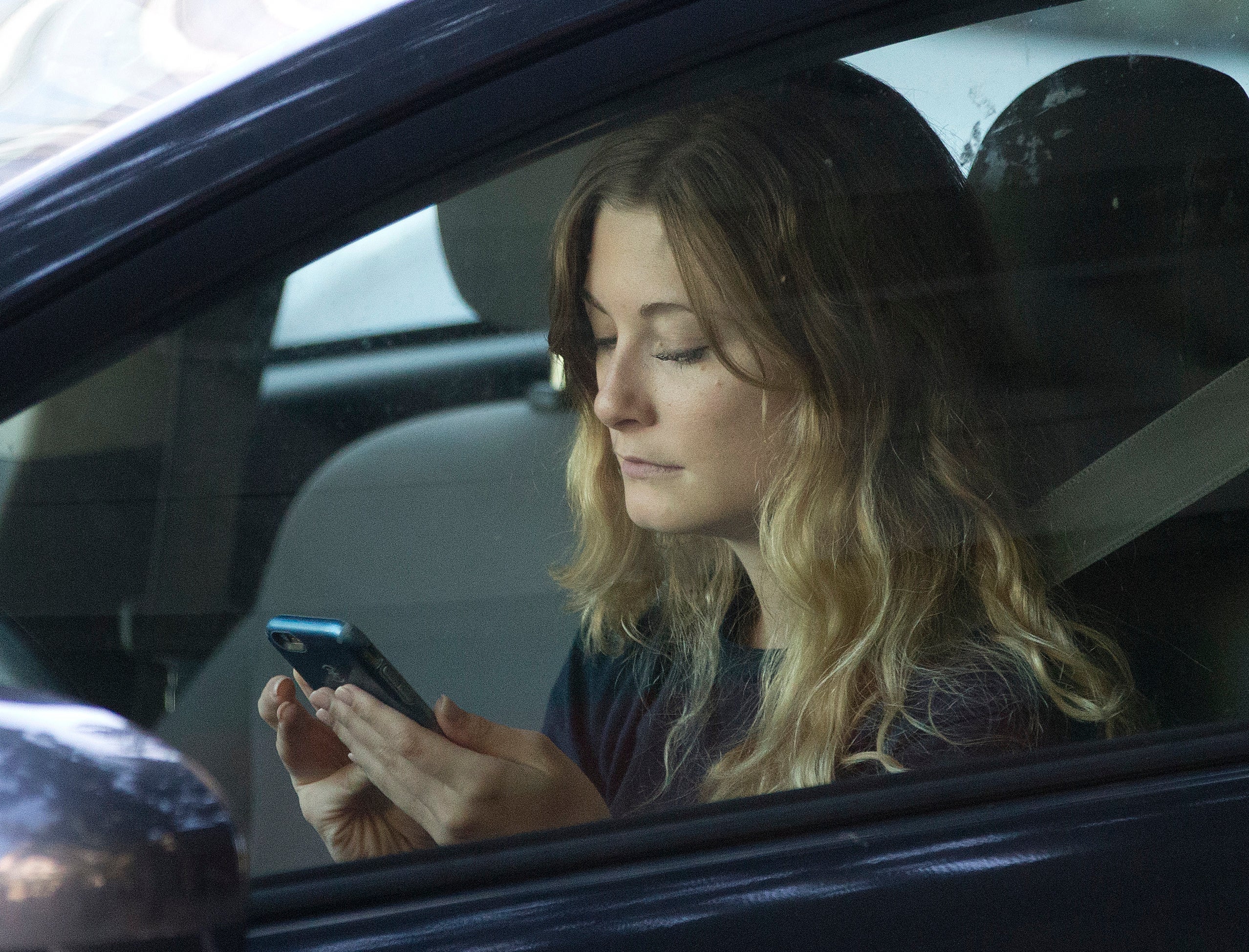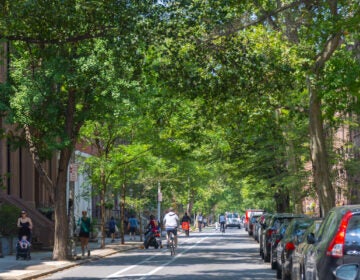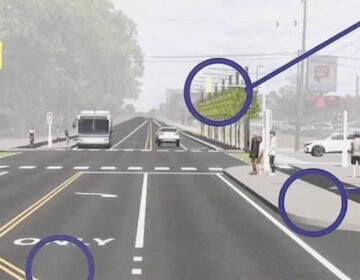Can Pennsylvania help drivers kick deadly cellphone addictions to the curb?

Christmas came in August to 6ABC, when two viewers sent in a video of a driver steering her car through I-76 traffic with her foot because her hands were busy tapping away on her cellphone. The gifted foot footage helped fill a few newscasts and made quite a few rounds on social media.
The dexterous driver’s brazen behavior doesn’t fully account for the video’s virality. Rather, it’s the fact that this was such an egregious example of a bad habit almost all of us practice— distracted driving—that drove so many to share the story. Her behavior was both intimately familiar and comically abhorrent, the perfect combination for posting on a friend’s Facebook page with a “and you thought I was bad, lol!”
According to a 2015 telephone survey by AT&T, 61 percent of U.S. adults admitted to texting while driving. Another third said they e-mail, and over a quarter peruse the internet. Those numbers are just who came clean, meaning the real figures are probably higher.
Nationwide, distracted driving contributes to 16 percent of all fatal crashes, according to AAA, causing more than 5,000 deaths a year. Those figures include all forms of driver distraction—not just cell phone use—including fiddling with the radio, eating, or taking off a jacket. In Pennsylvania, distracted driving caused 14,805 crashes in 2015, making it the second highest causal factor behind speeding (drunk driving led to 9,520 crashes, but those were more likely to be fatal).
The average person takes their eyes off the road for five seconds when they read a text or email, says Jaina Tidwell, manager of public and government affairs for AAA-Mid Atlantic. “If you’re driving at 55 miles-per-hour in that five seconds, you’ve gone the length of an entire football field while your eyes are off the road.”
That’s more than enough time for a driver to find himself in a bad situation, says Tidwell, but a driver’s attention remains diverted for longer than just the time it takes to react to your phone’s buzz or beep.
“Mental distraction case last as long as 27 seconds after you do something with that smart phone,” says Tidwell. Your hands may return to the wheel, and eyes to the road, but your mind’s eye remains elsewhere, focused still on the recently ended communication. If you’ve ever started driving while your mind wandered, only to seemingly wake up at your destination—or somewhere along your regular commute, even though you meant to go some place else entirely—you’ve experienced this phenomena.
Incidents of distracted driving seem to be increasing thanks to our handheld internet addictions. Recent studies from the National Safety Council have suggested that cellphone use while driving contributed to over a quarter of all car crashes.
Pennsylvania’s distracted driving laws do not comply with federal guidelines, which require escalating fines for repeat offenders and a complete ban on cell phone use by drivers under 18. The U.S. Department of Transportation is authorized to issue up to $23 million a year in grants to combat distracted driving, but has spent far less than that, records show. The Fixing America’s Surface Transportation Act, passed last year, loosened the grant requirements considerably, but not enough for Pennsylvania to qualify under its current laws.
Pennsylvania banned cellphone use while driving in 2011, but that law is now badly outdated. It only bans using phones or other wireless devices “to send, read or write a text-based communication while the vehicle is in motion.” Arguably, that prohibition doesn’t include playing games, flipping through photo albums, or watching video.
Pennsylvania imposes a smaller penalty on distracted drivers than its nearby peers: just $50, compared to $200 to $400 in New Jersey. Delaware increased fines this summer, to $100 for the first violation, and $200-300 for subsequent offenses. Repeat offenders could also face license suspension, a penalty previously reserved for the drunk and reckless. AAA and other safety groups supported the increased penalties in Delaware.
Pennsylvania’s penalty “seems pretty low considering how dangerous it is,” says Randy LoBasso, spokesman for the Bicycle Coalition of Greater Philadelphia. The Bicycle Coalition, Philly’s de facto advocates for the victims of bad driving, supports increasing the fines and would also like to see more charges against negligent drivers when they seriously harm or kill someone. But the Bicycle Coalition really wants to see is stepped enforcement, says LoBasso: Catching more violators is more important than penalizing caught violators more. That’s why the Coalition has been focused on red light and speed enforcement camera legislation.
But even if Pennsylvania changed its distracted driving law, would that really change driver behavior?
DO AS I SAY, NOT AS I DO
Increasing fines may appease our moral indignation, but it tends to have limited impact on influencing behavior, says Dr. Robert Kurzban, professor of psychology at the University of Pennsylvania. “Incentives like this are relatively weak.”
Larger penalties will only influence a person’s behavior if two things are true, says Kurzban. First, the person has to be aware of the penalty, and odds are you haven’t memorized a schedule of the fines attached to Pennsylvania’s various moving violations. “Second, people have to have pretty generous beliefs about the probability of being caught [and actually penalized],” Kurzban says.
As it turns out, most people discount the likelihood of being held accountable, especially when a law seems to be rarely enforced. Police in Pennsylvania may be issuing more distracted driving citations, but the vast majority of incidents go unpunished.
Texting-and-driving suffers from a bridge-jumping problem: Everyone else seems to be doing it. Only one-third of respondents to an Erie Insurance survey admitted to texting-and-driving, but three-quarters said they’ve seen others do it. That helps explain why 80 percent of respondents in an AAA study said texting or emailing behind the wheel was completely unacceptable, while 42 percent said they have read a message while driving and 31 percent admitted to typing one as they drove. People are less likely to follow rules, even those they wholeheartedly support, when it looks like no one else is.
Prohibitions against cell phone use also suffer from what behavioral psychologists call the Lake Wobegon effect: Like the children in Garrison Keillor’s fictional Minnesota town, a vast majority of people think they’re above average drivers and multi-taskers. According to a survey by Allstate, 64 percent of U.S. drivers rate themselves “excellent” or “very good” drivers. Only two percent of the population can truly multitask effectively, and the better a person thinks they are at multitasking, the worse they tend to actually be.
Nudging away distraction
Recently, a New York Times headline posed a simple question: “Phone Makers Could Cut Off Drivers. So Why Don’t They?”
Cell phone companies recognize the problem with distracted driving. Apple filed a patent on a lockout function back in 2008, which was granted in 2014. AT&T’s driver surveys were part of its voluntary “It Can Wait” campaign, and the cellular coverage provider also developed a DriveMode app that automatically disables notifications when a phone’s GPS detects its moving fast. A user can disable DriveMode with a few simple thumb swipes.
Other applications feature similar functions: Both Snapchat and Pokemon Go will ask users in traveling cars (or other sufficiently swift transportation, like trains) if they are driving, requiring them to proactively attest to the contrary.
Competitive forces make it unlikely that cell phone makers or service providers will voluntarily and universally implement these kinds of driver safety technologies. No company wants to unilaterally impose a feature that will annoy customers—the PR boost from putting safety first probably wouldn’t make up for the users who cannot stand the nettlesome reminders.
Nor is it likely that lawsuits will force cell companies to provide apps for functions that restrict usage during driving: The argument that the industry has a duty to prevent drivers from using their cell phones is probably a bridge too far for tort law, which generally limits liability when cause and effect are so attenuated.
Verizon and Apple both told the New York Times that current laws on distracted driving are insufficient. Currently, 46 states ban against texting-and-driving and another 14 ban hand-held mobile phone use all together. It appears that none attempt to require wireless providers or device manufacturers to limit a phone’s functionality while its user is driving. Then again, drafting such a state law would be difficult; federal laws preempt state regulations on most issues related to wireless communications. That would leave the matter to Congress.
While AAA’s Tidwell offered general support for functions that offer drivers safety reminders or limit functions, she held back from endorsing a legislative mandate. “That’s not going to fix the problem,” she said.
Convincing drivers to willingly download those apps, however, might have more impact than simple prohibitions and fines, says Kurzban. “The psychological literature says that making the decision beforehand—committing—is often a more effective strategy than white knuckling it.”
In the heat of the moment, we tend to buckle to temptation, Kurzban noted, whether it’s eating junk food when we’re hungry or picking up a phone when it rings. If we make the decision not to answer in advance by activating a driver lockout app, like grocery shopping when we’re full, we can avoid testing our often-disappointing mettle.
But, says Kurzban, that just pushes the problem back: “How do you get people to [in advance] not want to text while driving?”
That’s where Tidwell says education steps in: Convincing drivers to accept they aren’t as capable of multitasking as they might think. Kurzban suggested that such education efforts should emphasize that the desired norm—not using one’s cell phone while driving—was also the popular norm: that most people don’t drive distracted. “That might be a bit more effective,” said Kurzban. But no matter how thoughtful the education, ubiquitous the lockout apps, heavy the fine, or strict the enforcement, people will keep driving distracted. After all, 30 plus years of MADD, DUI checkpoints, designated driver PSAs and breathalyzer ignition locks have only put a dent in drunk driving.
“The bottom line is,” says Kurzban, “behavior change is hard.”
WHYY is your source for fact-based, in-depth journalism and information. As a nonprofit organization, we rely on financial support from readers like you. Please give today.






